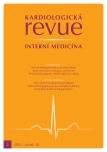New pharmacotherapy of diabetes
Authors:
T. Edelsberger
Authors‘ workplace:
Diabetologická ambulance, Krnov
Published in:
Kardiol Rev Int Med 2014, 16(2): 138-142
Category:
Internal Medicine
Overview
The article presents an overview of current and prospective pharmacological therapy of diabetes mellitus. New pathophysiological findings over the last decade have instigated efforts to find drugs that would be able to positively affect the newly discovered abnormalities in glucose metabolism and contribute to its impact on the treatment of diabetes. Some of these drugs, such as inhibitors of dipeptidyl peptidase 4 (DPP‑ 4) or glucagon‑like peptide 1 (GLP‑1) agonists, have been used successfully, and the others are waiting to be launched (SGLT‑ 2 inhibitor – dapagliflozin) or are undergoing different stages of clinical testing.
Keywords:
diabetes mellitus – antidiabetics – pharmacotherapy
Sources
1. Zinman B, Philis‑ Tsimikas A, Cariou B et al. Insulin degludec versus insulin glargine in insulin‑naive patients with type 2 diabetes: a 1‑year, randomized, treat‑ to‑ target trial (BEGIN Once Long). Diabetes Care 2012; 35: 2464– 2471. doi: 10.2337/ dc12– 1205.
2. Gough SC, Harris S, Woo V et al. Insulin degludec: overview of a novel ultra long‑acting basal insulin. Diabetes Obes Metab 2012; 15: 301– 309. doi: 10.1111/ dom.12052.
3. Rosenstock J, Bergenstal RM, Blevins TC et al. Better Glycemic Control and Weight Loss With the Novel Long‑Acting Basal Insulin LY2605541 Compared With Insulin Glargine in Type 1 Diabetes: A randomized, crossover study. Diabetes Care 2012; 36: 522– 528. doi: 10.2337/ dc12– 0067.
4. Bergenstal RM, Rosenstock J, Arakaki RF et al. A randomized, controlled study of once‑ daily LY2605541, a novel long‑acting basal insulin, versus insulin glargine in basal insulin‑treated patients with type 2 diabetes. Diabetes Care 2012; 35: 2140– 2147. doi: 10.2337/ dc12– 0060.
5. Caparrotta TM, Evans M. PEGylated insulin Lispro, (LY2605541)– a new basal insulin analogue. Diabetes Obes Metab 2013. doi: 10.1111/ dom.12196.
6. A Study of LY2605541 in Participants With Type 2 Diabetes Mellitus (IMAGINE 5). [online] Available from: http:/ / clinicaltrials.gov/ show/ NCT01582451
7. Morrow L, Muchmore DB, Hompesch M et al. Comparative pharmacokinetics and insulin action for three rapid‑ acting insulin analogs injected subcutaneously with and without hyaluronidase. Diabetes Care 2013; 36: 273– 275. doi: 10.2337/ dc12– 0808.
8. ORMD 0801 – Oral Insulin Capsule. [online] Available from: http:/ / oramed.com/ index.php?page=14
9. Zisser H, Jovanovic L, Markova K et al. Technosphere insulin effectively controls postprandial glycemia in patients with type 2 diabetes mellitus. Diabetes Technol Ther 2012; 14: 997– 1001. doi: 10.1089/ dia.2012.0101.
10. Kovatchev BP, Renard E, Cobelli C et al. Feasibility of outpatient fully integrated closed‑ loop control: first studies of wearable artificial pancreas. Diabetes Care 2013; 36:1851– 1858. doi: 10.2337/ dc12– 1965.
11. Phillip M, Battelino T, Atlas E et al. Nocturnal glucose control with an artificial pancreas at a diabetes camp. N Engl J Med 2013; 368: 824– 833. doi: 10.1056/ NEJMoa1206881.
12. Forst T, Weber MM, Pfützner A. Cardiovascular benefits of GLP‑1‑based herapies in patients with diabetes mellitus type 2: effects on endothelial and vascular dysfunction beyond glycemic control. Exp Diabetes Res 2012; 2012: 635472. doi: 10.1155/ 2012/ 635472.
13. Edelsberger T. Perspektivy v léčbě diabetu 2. typu – agonisté GPR119. In: Kvapil M. Diabetologie 2014. Praha: Triton 2014.
14. Edelsberger T. Perspektivy v léčbě diabetu 2. typu – agonisté GPR40. In: Kvapil M. Diabetologie 2014. Praha: Triton 2014.
15. Edelsberger T. Glukuretika (inhibitory SGLT2, glifloziny) v léčbě diabetu. Remedia 2011; 1. [online] Dostupné z: http:/ / www.remedia.cz/ Clanky/ Prehledy‑ nazory‑ diskuse/ Glukuretika‑inhibitory‑ SGLT2– glifloziny‑ v‑ lecbe‑ diabetu/ 6- F‑ 11R.magarticle.aspx
16. Edelsberger T. Perspektivy farmakoterapie diabetu 2. typu: Inhibitory SGLT2. DMEV 2009; 12: 9– 14.
17. Edelsberger, T. Perspektivy farmakoterapie diabetu 2. typu: aktivátory glukokinázy. DMEV 2009; 13: 113– 120.
18. The Web site devoted to the study of the glucagon‑like peptides. [online] Available from: http:/ / www.glucagon.com/ glucagonreceptorantag.html
19. Xiong Y, Guo J, Candelore MR et al. Discovery of a novel glucagon receptor antagonist N‑ [(4- {(1S)- 1- [3- (3, 5- dichlorophenyl)- 5- (6– methoxynaphthalen‑ 2- yl)- 1H‑ pyrazol‑ 1- yl]ethyl}phenyl)carbonyl]- b‑ alanine (MK‑ 0893) for the treatment of type II diabetes. J Med Chem 2012; 55: 6137– 6148. doi: 10.1021/ jm300579z.
20. Sullivan TJ, Dairaghi DJ, Krasinski A et al. Characterization of CCX140– B, an orally bioavailable antagonist of the CCR2 chemokine receptor, for the treatment of type 2 diabetes and associated complications. J Pharmacol Exp Ther 2012. doi: 10.1124/ jpet.111.190918.
21. Hoffmann E, Wald J, Lavu S et al. Pharmacokinetics and tolerability of SRT2104, a first‑ in‑class small molecule activator of SIRT1, after single and repeated oral administration in man. Br J Clin Pharmacol 2013; 75: 186– 196. doi: 10.1111/ j.1365– 2125.2012.04340.x.
22. Goldfine AB, Conlin PR, Halperin F et al. A randomised trial of salsalate for insulin resistance and cardiovascular risk factors in persons with abnormal glucose tolerance. Diabetologia 2013; 56: 714– 723. doi: 10.1007/ s00125– 012– 2819– 3.
23. Ramos‑ Zavala MG, González‑ Ortiz M, Martínez‑ Abundis E et al. Effect of diacerein on insulin secretion and metabolic control in drug‑naive patients with type 2 diabetes: a randomized clinical trial. Diabetes Care 2011; 34: 1591– 1594. doi: 10.2337/ dc11– 0357.
24. Orban T, Bundy B, Becker DJ et al. Type 1 Diabetes TrialNet Abatacept Study Group. Co‑ stimulation modulation with abatacept in patients with recent‑ onset type 1 diabetes: a randomised, double‑blind, placebo‑ controlled trial. Lancet 2011; 378: 412– 419. doi: 10.1016/ S0140– 6736(11)60886– 6.
25. Lernmark A, Larsson HE. Immune therapy in type 1 diabetes mellitus. Nat Rev Endocrinol 2013; 9: 92– 103. doi: 10.1038/ nrendo.2012.237.
Labels
Paediatric cardiology Internal medicine Cardiac surgery CardiologyArticle was published in
Cardiology Review

2014 Issue 2
Most read in this issue
- Centraly acting antihypertensives – rilmenidine
- Mechanical circulatory support in the treatment of cardiogenic shock – review
- Mechanical circulatory support and heart transplantation for treatment of chronic heart failure
- Non‑ pharmacological treatment of heart failure in terms of the new European guidelines for resynchronization therapy
